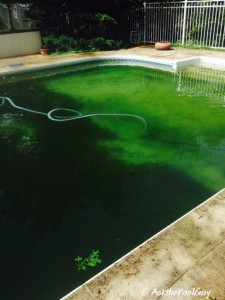 There are different forms and colors of algae. Some forms of algae are aquatic, and some are not. Algae uses the sun to perform photosynthesis to manufacture it’s own food. Algae varies in color and in form – which makes it adaptable to different conditions.
There are different forms and colors of algae. Some forms of algae are aquatic, and some are not. Algae uses the sun to perform photosynthesis to manufacture it’s own food. Algae varies in color and in form – which makes it adaptable to different conditions.
Algae is microscopic in size. By the time you see it in your pool it is an advanced bloom. There are products to help you keep algae from taking over.
1. Keep your sanitizer level at 1-3ppm of Chlorine to prevent algae.
2. Use a weekly algae preventative.
3. If you do have an algae bloom treat, and also treat for phosphates (food for algae). High phosphate levels can lead to algae taking over.
GREEN ALGAE: The most common form of algae
Green Algae varies in color from blue-green to yellow-green and dark green. It can float in the water and turn the wall hazy and green. It can also cling to the wall in patches.
Green algae found on the wall can range from small areas to the entire surface of teh pool being coated. Green algae can clog filters – it can also cause surface damage if left untreated. Treat green algae with shocking the pool to a super chlorinate level (most inground pools 15k-20k gallons will take 4 gallons of liquid chlorine in extreme algae cases, or at the pool opening if the pool is green.)
Some green algae, which is small celled, may cling to the pool surface and the water will remain clear. Treating this as a copper or mineral problem at first glance is common – though it is algae. This type of algae is also resistant to even high levels of chlorine and will “eat up” chlorine quickly. Treat aggressively with shocking, algaecides, and phosphate removers.
In the middle of the summer green algae patches may form in the pool, especially in shady areas such as below the return eyeballs and inside the mouth of the skimmer. The water may remain clear and yet have a “stinging” sensation. This is normal green algae and may result from low levels of sanitizer and the pH and alkalinity running low in the pool.
If any of these are the case, have your water tested and analyzed for the exact water chemistry numbers. Treat with a shock, a good algaecide and brushing/cleaning of the entire pool and pool equipment.
In the case of a Baquacil Pool or pools with alternative sanitizing methods such as Soft Swim or Buguanizes, the Bactericide level should be topped up, and double doses of shock and algaecide should be used.
